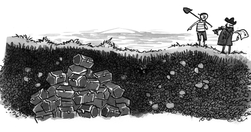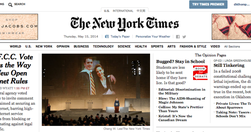
2015 is the Year of the Card. Screen-size cards are everywhere, from websites to native apps and are designed to look like their physical counterparts. It’s an easy way for you to shuffle through a series of digital containers with the flick of a thumb...cards are a style that seems just made for apps.
"The New York Times today introduced “Watching,” a major new feature on the NYTimes.com homepage on desktop and on the mobile website. Watching is a stream of developing and noteworthy news designed to amplify the scope and urgency of The Times’s digital report. Watching offers a tailored feed of the news of the moment, such as early outlines of …
"The Guardian released a beta version of its new website to get reader feedback as it continues to tweak its design.... Content discovery is a major focus ... “container model” allows the paper to implement a responsive design while also retaining a story hierarchy, user experience director... Each item contains a story, which are put together…

At last, someone else using gardening metaphors when discussing content strategy & information architecture: "The stream—that great glut of ideas, opinions, updates, and ephemera that pours through us every day—is the dominant way we organize content.... Problem is, the stream’s emphasis on the new above all else imposes a short lifespan on conte…

"what type of organisation gets a presence on GOV.UK - and what sort of presence they get. " Interestingly similar model to the E2G 'variable geometry' portal architecture developed around 12 years ago, albeit with additional features - notably Groups, recently made more flexible. - GOV.UK organisation types: a user guide (updated June 2014)…
More titbits from that internal NYT digital report: "There are about 14.7 million articles in the Times’ archives back to 1851 ... We can be both a daily newsletter and a library — offering news every day, as well as providing context, relevance and timeless works of journalism.” " - The leaked New York Times innovation report is one of the key d…

"The New York Times lost 80 million homepage visitors—half the traffic to the nytimes.com page—in two years.... this will make the news more about readers ...[because] homepages reflect the values of institutions, and Facebook and Twitter reflect the interest of individual readers [who] aren't interested in hard news, but rather entertainment, se…
Interesting approach to covering a story from a site known for long-form, no-click content: short-form, multi-click content: "Content is broken into small parts, and many of the main points are expandable ... This is mostly quick-hit aggregation ... a stream of posts that don’t require clicking to separate pages. " - Quartz launches Glass, a “no…

Deadtree media to do more with legacy content than paper birdcages! The latest high-profile move into explanatory journalism is New York Times' The Upshot: "offer a combination of data journalism and explanatory reporting ... head-to-head with Ezra Klein’s Vox and Nate Silver’s FiveThirtyEight ... a kind of internal aggregator and explainer for…

And not just journalists. New generation news sites are redefining news and, by consequence, rethinking information architecture, content strategy and CMS. I only hope the results filter through to everyone else, and sooner rather than later. "... a moment when young talent began demanding superior technology as the key to producing superior jour…
A new generation of companies, like CIRCA, are redefining the structure of how information is treated, and building new CMS to support it. Their approach will inevitably feed into a new generation of CMS for whom the 'article' and 'page' are, if not meaningless, at least optional. And I for one can't wait. "what we’re really doing at Circa is a…